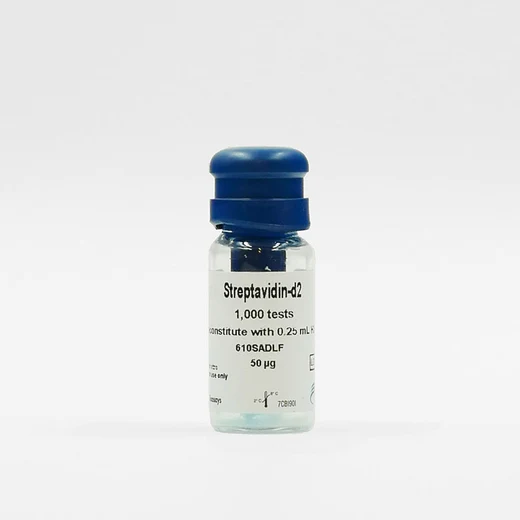
首页
HTRF STREPTAVIDIN-D2 - 1K PTS


品牌: Revvity
 下载产品说明书
下载产品说明书 下载COA
下载COA 下载SDS
下载SDS 用小程序,查商品更便捷
用小程序,查商品更便捷



 收藏
收藏
 对比
对比 咨询
咨询
产品介绍
产品信息
Overview
Streptavidin has been labeled with d2. Biotin binds to Streptavidin with high affinity (Ka=1015M-1). The binding is rapid and stable, making it an ideal choice for use in a variety of assays such as enzyme assays, protein-protein binding assays and molecular biology assays.
Specifications
| Assay Points | 1000 |
|---|---|
| Assay Target Type | Fluorescent reagent |
| Assay Technology | HTRF |
| Brand | HTRF |
| Quantity | 1 |
| Therapeutic Area | Cardiovascular Infectious Diseases Inflammation Metabolism/Diabetes NASH/Fibrosis Neuroscience Oncology & Inflammation Rare Diseases |
| Unit Size | 1,000 Assay Points |
Video gallery
How it works
Assay principle
In an HTRF interaction assay, one partner is labeled (directly or indirectly) with the donor, and the other with the acceptor (again, directly or indirectly). The intensity of the signal is proportional to the binding of the 2 partners.
In the example shown here: Streptavidin-d2 binds to the biotinylated partner A while partner B* binds to a specific antibody labeled to an HTRF donor.
*partner B can also be tagged, Fc fused. In these cases use for the detection, the corresponding HTRF reagent (anti-Tag, anti-species, protA, Streptavidin), labeled with donor.

Assay protocol
The example on the right describes the protocol using a 20 µL final assay volume for detecting an interaction between a biotinylated-tagged partner A and a non-tagged partner B*.
Dispense the 2 partners (10 µL), incubate, add Streptavidin-d2 (5 µL) and anti-partner B labeled with donor (5 µL), incubate and read.
*partner B can also be tagged, Fc fused or directly labeled. In these cases use for the detection, the corresponding HTRF reagent (anti-Tag, anti species, protA, Streptavidin), labeled with donor.

Assay details
Build HTRF interaction assays for your specific application
Reagents are sold by the number of tests (20 µL reactions). XL665 or d2 conjugatesare supplied on the basis of 20 ng of antibody per well. The amount of active moiety per vial is also provided (as well as the number of tracers per vial - see product description sheet). The active moiety is defined as the active part of a conjugate (e.g. antibody).
How do the number of tests relate to active moiety?
The average conjugate quantity per well reflects overall biological material content. Using the active moiety amount is generally preferred to the quantity of total conjugate. For Cryptate and d2 conjugates, the total conjugate amount equals that of the active moiety, since the molecular weight of the label is negligible. This is not the case for XL665 labeled entities for which the quantity of total conjugate will vary depending on the final molar ratio of the XL665 conjugate, however, the amount of active moiety, provided by Revvity, is constant and based on the number of tests ordered.

Recommended quantities of Cryptate and XL665 conjugates
Cryptate conjugates must not be excessive in order to prevent reader saturation and an unacceptable level of background. In most cases, a cryptate concentration of 1 to 5nM is appropriate, and will generate 20,000 to 80,000 cps at 620 nm depending on the HTRF compatible reader used. The XL665 conjugate must match its assay counterpart as closely as possible in order for the maximum number of biomolecules to be tagged with the XL665 acceptor. Thus, to detect a tagged molecule at an assay concentration of 20nM, the concentration of anti-Tag-XL665 should be equimolar or higher.
声明 :本官网所有报价均为常温或者蓝冰运输价格,如有产品需要干冰运输,需另外加收干冰运输费。








 危险品化学品经营许可证(不带存储) 许可证编号:沪(杨)应急管危经许[2022]202944(QY)
危险品化学品经营许可证(不带存储) 许可证编号:沪(杨)应急管危经许[2022]202944(QY)  营业执照(三证合一)
营业执照(三证合一)